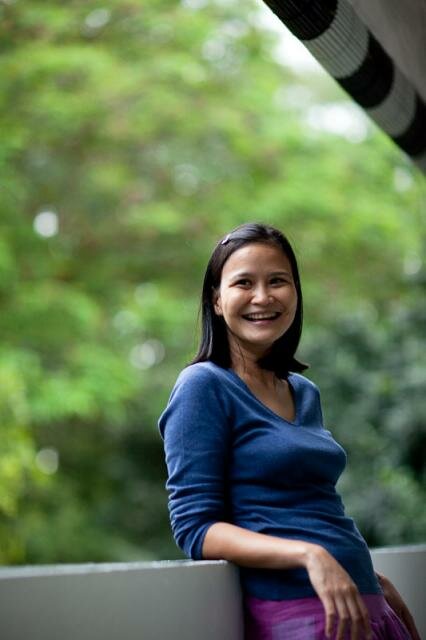Finding the Perfect Pitch
Shuehli Ong, who treks across the US playing the theremin, tells us why she’s smitten with the grand-daddy of electronic musical instruments.
asia!: You play the theremin, and you’ll be performing at the Singapore Arts Festival in June. But first – what’s a theremin?
Shuehli: The theremin is the oldest electronic musical instrument. It possesses two antennas on either side of the body; the right one for pitching (frequency) and the left one for manipulating volume (amplitude). The volume antenna allows the thereminist to affect dynamics and articulation when used along with the pitch antenna. Played with precision hand movements, the capacitance in each hand affects the electro-magnetic field generated by the antennas, altering pitch and volume. All you sci-fi fans, this is your kind of candy!
asia!: What attracted you to it?
Shuehli: I wanted an instrument to represent my interest in the history of electronic music. I am also a trained synthesizer programmer-performer. I consider my synth work to be an extension of my electronic music study in its “current” state, whereas the theremin is my reckoning with a moment in the inception of music technology.
Despite the fact that the theremin is the grand-daddy of all electronic musical instruments, it bares no resemblance whatsoever to a synth. It must be tackled with an entirely different mindset. I became very much smitten by its enigma, almost like an infatuation. The theremin has become a major part of my musical arsenal.
asia!: Can you fill us in on your background, and your journey so far as an experimental musician?
Shuehli: I was born in Melbourne, Australia to Singaporean parents. I spent my university years both in Adelaide and Melbourne. My interest in live performance and new technology has shaped my career and taken me into various fields related to entertainment.
I moved to Singapore during the multimedia boom to work in the industry. But it was not long before the itch to perform and make my own music compelled me to form a company to design and stage live performance designs and original shows. I became well known as an experimental artist because of the esoteric nature of these shows.
After some time, I felt I needed to reinstate my personal aspirations and sound. This attempt became known as the electronic project: Xenovibes. I wanted people to understand that I was as pop as I was esoteric. Xenovibes was to try and reach a wider audience with my sound; an amalgamation of my musical training (western classical and music technology) and ethnicity (Australian-Chinese.)
The opportunity to expand my horizons came in the form of a trek across to the States on a visa for Artists of Extraordinary Ability, awarded by the US government and American Federation of Musician. I have performed at shows and venues that cover all forms of popular music including country music revues and festivals. America is fertile ground for the work I pursue and I've appreciated the opportunities offered and the people who have been a part of it.
asia!: Do you write your own music and if so, what inspires your compositions?
Shuehli: I am a composer and songwriter. I have written large format productions, dramatico works and music for theatre, and I have published three CDs to this date. I am going through a period where I have a wanting to play to more intimate crowds; in January this year, I put on my first house concert in California which left me with an insatiable appetite for more.
I follow the same inspirations for the delicate job of recording and producing in the studio (and stage) when I work with other artists. I’ve also learnt plenty from these professionals. One such person was guitarist Dean Parks, who appears on Xenovibes’s 3rd CD ‘Xing Paths’. Dean is the epitome of the accomplished musician; humble, ultra professional, informed and so versatile.
asia!: You also play the tin whistle. What’s that?
Shuehli: The tin-whistle can be considered a simple instrument. It is diatonic, meaning there is one tin whistle for every key, to include its relative minor and associated keys; i.e. those with common accidentals in the key-signatures. Like the theremin, the instrument has a complex set of playing techniques for articulation and sound production. The tin-whistle is often associated with Celtic music.
asia!: Tell us a bit about your lifestyle. Are you a rolling stone now?
Shuehli: Recently, there have been requests for me to perform in Italy, the UK, Mexico, Germany, Japan, Spain, Australia, and I have a good following in Hong Kong, China, Russia and Canada as well, so I am hoping for a fulfilling concert itinerary to include requests for house concerts from individuals anywhere in the world.
As you know, I’ve been invited by the Esplanade to be a part of the Singapore Arts Festival’s Flipside program in June. I’ll be accompanied by local string quartet, Artsylum, playing some popular numbers as well as my own songs on the theremin. I’m excited about meeting my fans in Singapore. I’ll autograph any CDs bought! Updates of this show will be posted on my Twitter feed.

Hugging it close: Shuehli and her beloved theremin
Photo credit: Shuehli Ong
Shuehli Ong will be performing at Flipside, part of the Singapore Arts Festival, on June 7 to June 10. There will be two shows per night, at 7:15 pm and 8:15 pm.
You can listen to samples of Shuehli’s music here, as well as join her on her Facebook page.



 Clarissa is a journalist who focuses on travel and the arts. As a desperately hopeful author, she writes short stories and is working on a novel. Clarissa won the Spectator’s final Shiva Naipaul Memorial Prize for travel writing.
Clarissa is a journalist who focuses on travel and the arts. As a desperately hopeful author, she writes short stories and is working on a novel. Clarissa won the Spectator’s final Shiva Naipaul Memorial Prize for travel writing.













